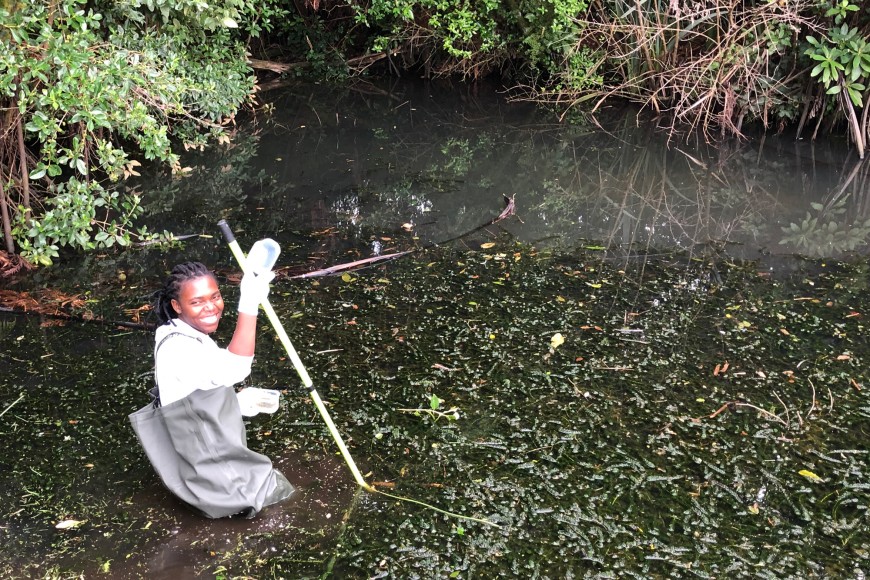Is Lagarosiphon a Good Target?
A biocontrol programme for lagarosiphon was considered in Ireland in the early 2010s, and two candidate agents, a leaf-mining fly (Hydrellia lagarosiphon) and a shoot-mining midge (Polypedilum tuburcinatum), were prioritised. Testing of the leaf-mining fly was completed, which showed it to be host-specific. Preliminary testing was started on the midge, but this was not completed due to a hiatus in funding, and the project has not been renewed and no agents were released. Given our interest in pursuing a biocontrol programme for lagarosiphon here, we piggy-backed on the research in Ireland with the hope of releasing both agents simultaneously.
As part of our baseline research for the programme it was important to assess whether biocontrol is likely to be an effective management tool for lagarosiphon. Only two submersed aquatic plants, dense water weed (Egeria densa) and hornwort (Ceratophyllum demersum), have biocontrol programmes elsewhere in the world (USA and South Africa, respectively), and so far control attempts have had only limited to partial success. As part of this undertaking we employed a PhD candidate, Nompumelelo Baso, at Rhodes University in South Africa, with an interest in understanding the success of invasive species in their introduced ranges. Nompumelelo is particularly fascinated by the ‘enemy release hypothesis’ (ERH), which states that invasive species have an advantage over native species because they are freed from their natural enemies. In the absence of herbivory and disease, invasive species can focus on growing and reproducing, becoming more competitive than they are in their native range.

Nompumelelo sampling at King Edward Park, Stratford
As part of Nompumelelo’s research she tested the ERH by comparing lagarosiphon biomass and other factors in the native range of South Africa, where the candidate biocontrol agents are present, to the same parameters in New Zealand, where lagarosiphon was presumed to not have any significant natural enemies. “To do this, I travelled to the plant’s native distribution range in South Africa, collecting biomass samples with a specially designed submersed macrophyte sampler a.k.a. ‘the crank’,” explained Nompumelelo. “The crank has blades that cut the stems of lagarosiphon from root to tip to get a measure of weight per unit area. This is then repeated for replication, and at multiple sites both in South Africa and New Zealand,” she added. Unfortunately, Covid disrupted Nompumelelo’s plans to do the research in New Zealand in 2021 and 2022, so the sampling was conducted by the project leader, Angela Bownes, and technician Arnaud Cartier. Fortunately she was able to join the most recent sampling trips undertaken in January and February 2023.
Although Nompumelelo’s analysis of the full data set is incomplete, a preliminary analysis showed that lagarosiphon has a remarkable tolerance for different environmental conditions. The results also indicate that the plant has higher biomass in its invaded range compared to the native range, supporting the theory that it can invest more in growth when freed from the pressures exerted by natural enemies. The study found that fewer plant species co-occur with lagarosiphon in the invaded range compared to the native range, further supporting the notion that it is a superior competitor without its natural enemies.
“Nompumelelo’s research has made a significant contribution to our understanding of lagarosiphon, and provides a strong indication that biocontrol has the potential to be a viable management option,” said Angela. “It tells us that herbivore pressure from introduced biocontrol agents can reduce its biomass and competitive dominance. Further, this effect should be maximised in New Zealand since the leaf-mining fly is heavily parasitised in its native range, whereas it is unlikely to be parasitised in New Zealand due to a lack of native analogues in our biota. Without this top-down pressure, the fly should build up good populations capable of reducing the invasiveness of lagarosiphon,” she added.
Next steps to progressing the biocontrol programme include completing host range testing of the shoot-mining midge, but obtaining a viable laboratory colony has been a challenge, one that is hopefully resolvable in the near future.
Funding
This project is jointly funded by the Ministry of Business, Innovation and Employment, as part of Manaaki Whenua – Landcare Research’s Beating Weeds programme, and the National Biocontrol Collective.
Key contact

